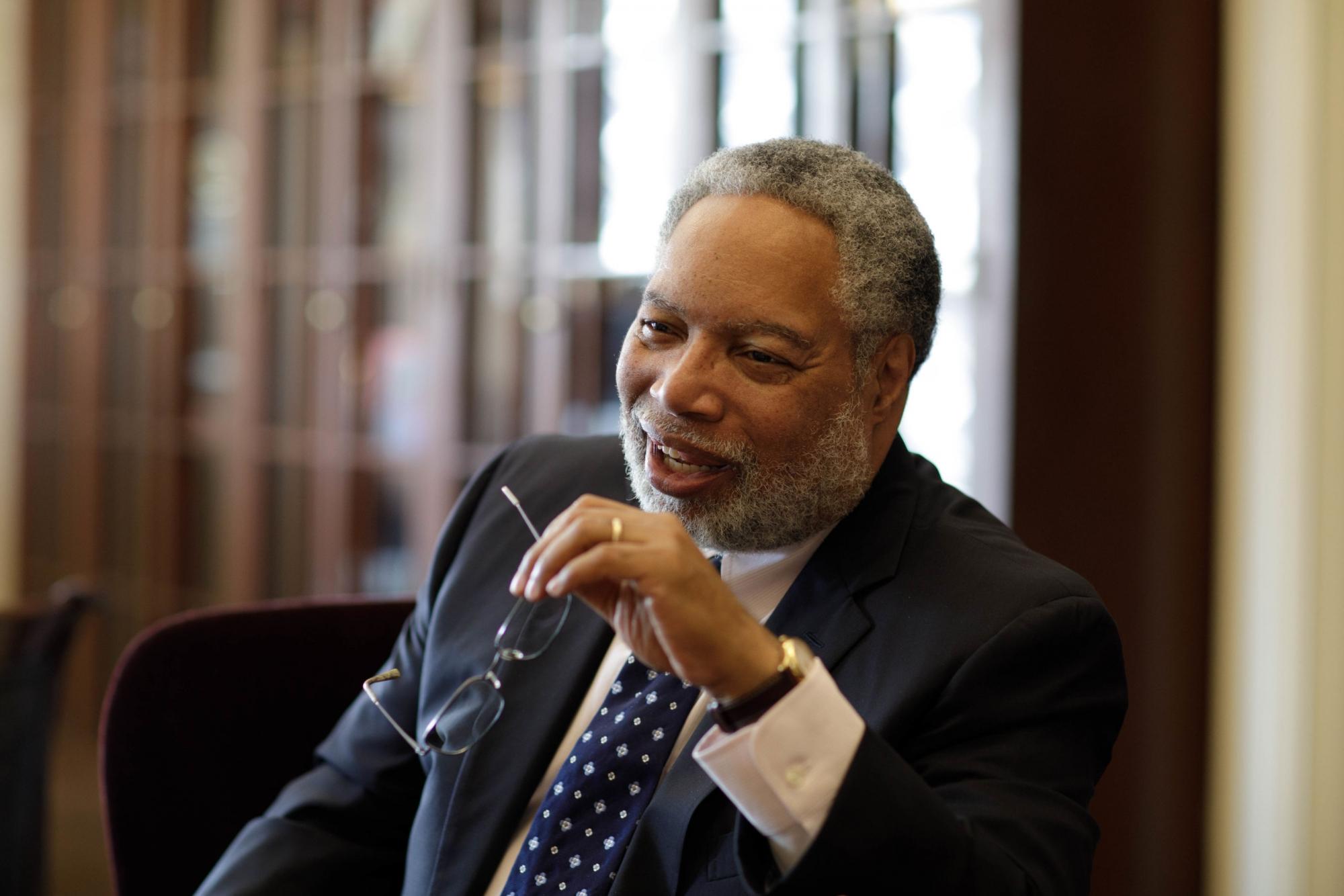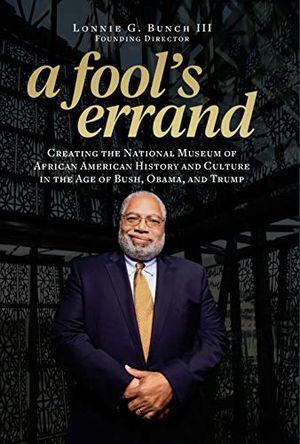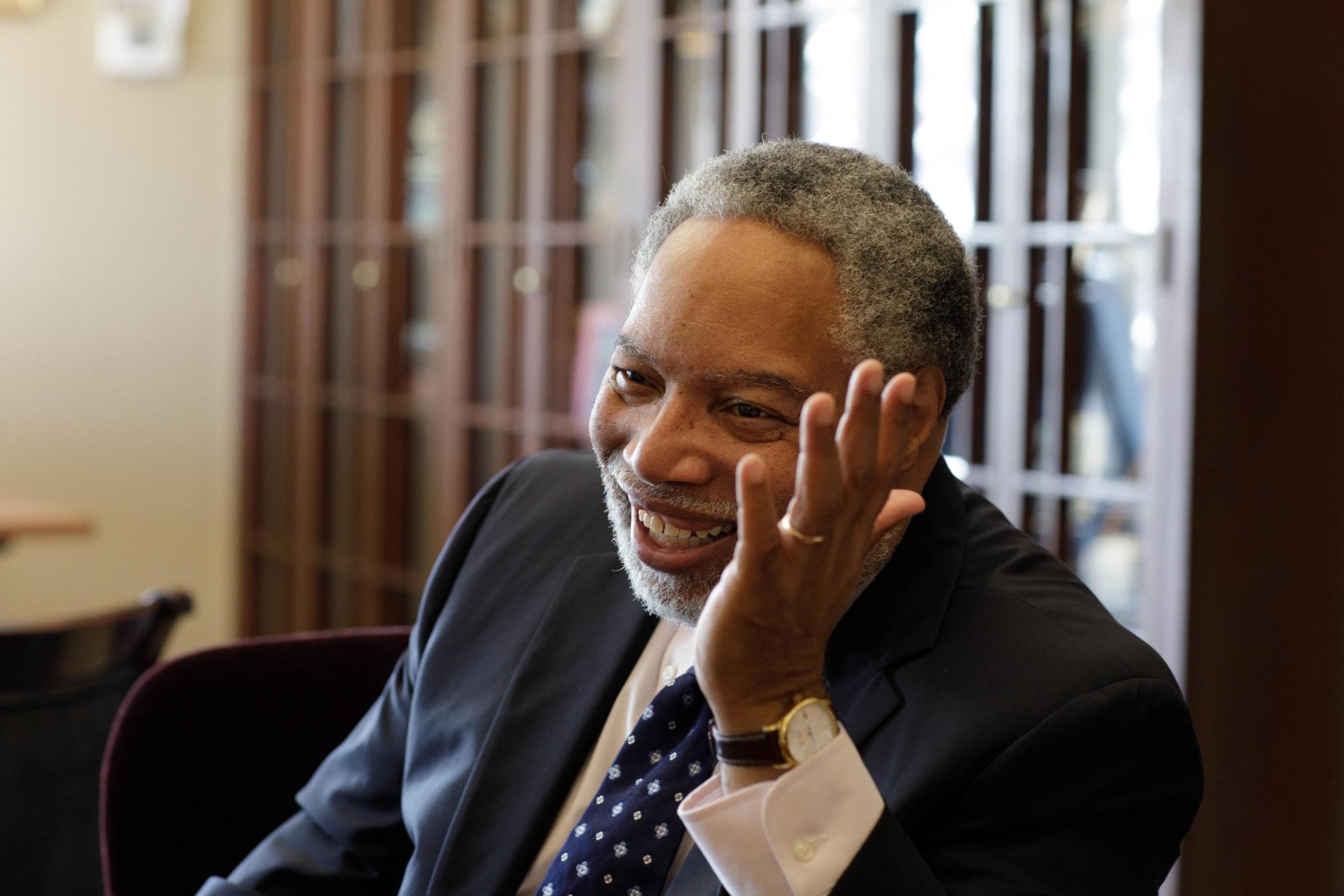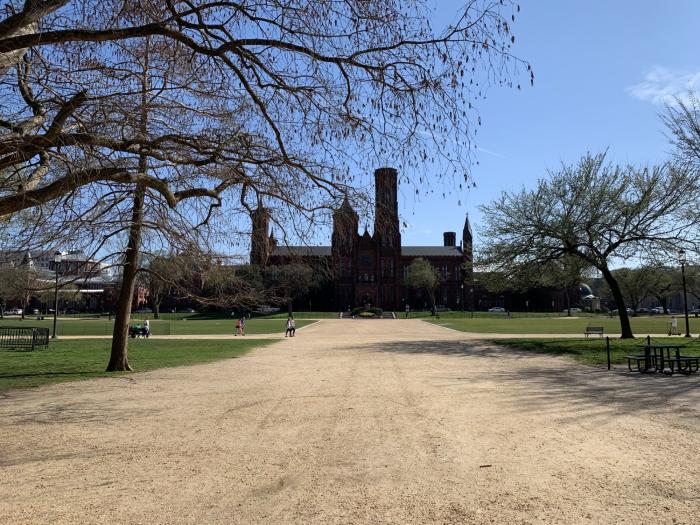A Late Morning With the Smithsonian Secretary
Lonnie Bunch spent a decade as a GW professor and then founded the National Museum of African American History and Culture. In March, he talked with “GW Magazine” about the importance of history, how we tell stories—and who tells them.
Story by Matthew Stoss
Photos by William Atkins
Originally, we were supposed to take a nice walk on the National Mall, eat hot dogs and maybe ride the carousel on his and his plastic horses while watching the tourists trudge and totter between the museums, monuments and bottled waters. But, alas, new Smithsonian Secretary Lonnie Bunch is a man in demand, and his time belongs to everyone else.
The former longtime GW museum studies and history professor is lord, protector and fundraiser-in-chief of the United States’ largest museum complex. The Smithsonian’s staid grandeur includes 19 museums, one zoo, some gardens, more than 6,600 employees, thousands and thousands of volunteers and a $1.6 billion budget. Bunch, a 67-year-old museum lifer and committed bibliophile with a beard that’s celebrating its 30th birthday, is so densely scheduled that even reading, once a lifestyle, has been forcibly demoted to a stolen-time hobby. He indulges in quiet moments, which are louder than they used to be.
So we’re convening on a clear, late morning at his office in the Castle, the regnant Romanesque structure that’s occupied the National Mall’s primest real estate since 1855, back when that bit of Washington, D.C., was largely undomesticated. It serves as Smithsonian headquarters. There are—again, alas—no hot dogs.
It’s the day before the Smithsonian goes dark. The coronavirus closed it, too, and you can almost see the End Times through the cherry blossoms. The secretary’s office looks like it belongs to someone who runs… the Smithsonian. Bunch, appointed by the institution’s board of regents in May 2019, is the 14th such person to do so and the first African American to hold the position. The Smithsonian was founded in 1846.
We made conversation for an hour or so at a round table, cozied by oil paintings, natural light, one long
wall of glass-immured books and within a few feet of a Jon Bon Jovi-signed Telecaster. Related to that—Bunch once got a mix cassette tape from LL Cool J, an acquaintance made last year in Los Angeles while Bunch toured his freshly released memoir about his decade-long building of the National Museum of African American History and Culture. A Fool’s Errand: Creating the National Museum of African American History and Culture in the Age of Bush, Obama, and Trump (Smithsonian Books, September 2019) includes and explains all the things that anyone ever wanted to know about how the museum came to be and what it took from Bunch emotionally to make it real.
Bunch also, through his work on the African American history museum, got to know, among others, the late Don Cornelius and Oprah, who calls him sometimes. She’s a board member at the NMAAHC, which Bunch began in 2005 and christened at a celebrity-flush ceremony in 2016. Former Presidents George W. Bush and Barack Obama were among the attendees.
“There is something really weird to me about the people that know me and call me,” Bunch says. I’d asked him about knowing Don Cornelius, confessing that I always wanted to go down the Soul Train line. Bunch responded by wishing me “Peace, love and souuuuuuul.” “I mean, yesterday I was talking to Steny Hoyer—you know, ‘How you doin’? What’s going on?’ Or, I’ve got a call into Oprah, and she’ll return my call. That to me is so weird.”
“How is your relationship with Congress?” I say. Hoyer, a Democrat from Maryland, is the House majority leader. I’m too intimidated to ask about Oprah.
The federal government funds the Smithsonian, although there are private donations, too. In 2019, those totaled $545 million. It’s important that Bunch makes elected friends.
“One thing that I realized when I came back in 2005,” he says, referring to his return to the Smithsonian from the Chicago Historical Society, where he served as president from 2001 to 2005, “was that whatever I did, I was going to be criticized, and I need to have congressional support. So I reached out very early to about 40 different people on both sides of the aisle, and I used to spend every week, whenever they were in session, I would actually go up there before I needed anything… and I’m still very close to those folks.
“One of the most humbling things was when I was announced as secretary, Nancy Pelosi organized a reception in my honor on the Hill, in the Capitol. That was so moving to me. It wasn’t a political thing, just as a friend, and that meant a lot to me to have Republicans and Democrats come. So that shows, I think, why we’ve been successful. People know that I will try to be as bipartisan as I can be—but I’ll be transparent. Doesn’t mean I’m not going to get beat up from time to time, but it means at least I have people I can go to, and I can say, ‘Hey, guess what’s happening? What’s the advice you can give to me to handle this?’”
“What did they serve at the reception?”
“I don’t know.” He’s smiling. “I was working the crowd.”
See. Fundraiser-in-chief.
Bunch grew up in Belleville, N.J., where he loved history, Sam Cooke and the New York Yankees. As an 11-year-old, he says, he waited in a long, long line to get autographs from Mickey Mantle and Roger Maris. But upon reaching the star Yankee outfielders, an adamantine handler informed Bunch that to get his notebook signed, he had to buy Mantle and Maris’s new book which detailed their 1961 race to break Babe Ruth’s single-season home run record of 60. Bunch didn’t have the money. He left with his notebook still bare.
Belleville, a town of about 37,000, is a suburb of Newark and historically Italian American. Bunch maintains high standards for pasta and red sauce. The town claims Joe Pesci and Frankie Valli among its famous natives and has purported ties to New York organized crime families. Bunch says that growing up he “knew people that knew people” and, laughing, added that “we had no crime,” making the classic (and mordant) joke about neighborhoods with mafia ties.
In the 1950s and ’60s, Bunch says, his family was one the few black families in Belleville and that it forced him to learn to how to fight, run and/or charm his way out of endangering confrontations. The charm, undiminished by the decades gone between, went only so far. In high school when he tried to visit the New Jersey Historical Society to research a history-class project, he says, a staffer denied him entry for having what was then deemed an inconvenient skin color.
“In those days, it was in an old Victorian house,” Bunch says of the New Jersey Historical Society. “But it had a big, heavy wooden door and it had a glass frame so you could see through. I remember putting on my high school letter sweater, doing everything I was supposed to do: getting on the bus, going to Newark and knocking on the door. And there was this woman, very blonde—I remember that—looking up. And she waved me away. And I knocked again and I sort of held up my little notebook to show her I was a student, and she waved me away.
“What it taught me was there must be something unbelievably important about history if they were going to wave people away. And in so many ways, my career has been about making sure nobody gets waved away when they want to understand the past.”
“...in so many ways, my career has been about making sure nobody gets waved away when they want to understand the past.”
“So you didn’t even get into the museum?” I say.
“I didn’t get in. Now, the end of the story is 30 years later. They give me an award. And so I decide to tell that story, and they were like, ‘Ohhh.’ But I framed it as the world has changed.”
Bunch got his bachelor’s, master’s and doctorate at American University before stops as a professor at various colleges, including GW from 1990 to 2000, and as a curator at various museums. He spent much of his career (12 years) at the National Museum of American History. He also had shorter stints at the Air and Space Museum, the California African American History Museum and the Chicago Historical Society. Then there was his 14-year run at the National Museum of African American History and Culture, a stop that now largely defines his time in the academy and nursed him toward a Smithsonian secretary candidacy.
Lonnie Bunch talks with GW Magazine in his office in the Smithsonian Castle in March.
Sitting in his office—it’s in a stately ell attached (and matched) to the Castle proper—Bunch, unsurprisingly, describes himself as a “lover of history.” After an icebreaker about Jean Harlow and 1930s cinema—he used to teach a film history course—Bunch philosophized and raconteured about the new voices from ignored places that induced academia to fund and admit other dispositions.
We start with Annette Gordon-Reed. She is a Harvard University professor known for her Pulitzer Prize-winning work elucidating Thomas Jefferson’s relationship with Sally Hemings, an enslaved woman at Monticello with whom Jefferson had multiple children. Her first book, Thomas Jefferson and Sally Hemings: An American Controversy, came out in 1997. She has since published five more books, including two on Jefferson.
“She offered a new perspective on something that had been written about for 200 years,” I say. “What’s the importance of having a black woman write about Thomas Jefferson and what has that done for academia, history, general knowledge, people’s perception, things like that?”
“I would almost argue that it’s even bigger than that,” Bunch says. “The most active field in the academy has been the study of black history, for the last 30, 40 years. Most active. Some of the most innovative scholars—whether it’s Annette Gordon-Reed—they have mined data in fundamentally different ways so you’re telling different stories. You’re privileging the enslaved and you’re looking at it through the lens of women. But more importantly, they’ve been able to say: How do you better understand America through the lens of whatever you’re writing about? That’s fundamentally different because it’s saying that the stories of African Americans—the stories written by African Americans are not ancillary stories but they’re the central stories to understanding who we are, and that’s what Annette does.
“Part of the power of history is you’re always in search of new discoveries. You’re always mining and thinking about things in different ways, and you’re also fundamentally shaped by the time you live in. So [for example] you ask yourself about gender in a way that you may not have 10 or 15 or 20 years ago. I think the exciting thing about history is that it’s always changing, always morphing.”
“I guess that’s happened contemporaneously with your tenure in academia?”
“I’d say that Annette is roughly my age”—she’s six years younger—“and we had the same sort of growth as scholars. I think you’ve gone from justifying that you’re exploring black history to recognizing that it’s the best way to understand what it means to be an American. It’s a real profound transformation.”
“What was that shift like in academia? Did you have to fight for it? Were the entrenched people like, ‘Nah, that’s silly?’”
“Part of the recognition was that you had, for the first time, a larger diverse pool of scholars. So therefore, they were raising different issues, and there were fights where you had to say, ‘This is a good dissertation topic, even though you don’t think it’s a good dissertation topic.’
“But I think what has happened is that as more of the amazing work came out, whether it was John Blassingame’s work in the ’70s on slave community, that you’re beginning to see people say, ‘Wow, there are really interesting new things to look at.’ You look at the work that’s come out about slave ships—fascinating stuff. We’d never thought about that. That’s because people ask different questions. I think the best thing about scholarship is you can have scholars ask different questions and find more nuanced answers.”
“I think the best thing about scholarship is you can have scholars ask different questions and find more nuanced answers.”
“How deeply has that penetrated today?”
“Oh, I think it’s very deep. I think that while the numbers are still smaller—there aren’t a large number of African American scholars in every department, but every department has African American scholars, which they didn’t when I was going to school. I think that the ideas have permeated. That doesn’t mean there hasn’t been a backlash. There have been the groups that have said: You’re balkanizing American history. So there’s always that.
“But I think what is interesting to me is that the scholars that are writing about race were initially telling stories to fill the voids—things that were left out of history. Now what they’re doing is writing the grand narratives—rethinking Jefferson through the lens of Sally Hemings. In a way, you had to have that foundation work that provided the knowledge base, and now you’re having scholars being able to say, ‘Let’s write about the sweep of history through this.’ When you think of Nell Painter’s work on the history of white people—fascinating stuff which really wouldn’t have happened without generations of the sort of grounding work.”
There’s a story easily found on the internet about Bunch being a kid and going to North Carolina to visit family—his grandfather, a sharecropper-turned-dentist, moved to New Jersey in the early 1900s—and then trying to eat lunch at the local Woolworth’s luncheonette, just like he did at the Woolworth’s in Newark. Once again, someone deemed his skin color inconvenient, this time to the practicing of good capitalism, and Bunch got sent hungry on his way.
This, in part, leads us to Richmond, Va., my hometown. It’s the former capital of the doomed Confederate States of America and the home of an avenue where a few of that stillborn nation’s dead generals are venerated, their four-year sedition romanced in stone and shaped metal. Here Bunch discusses the Lost Cause, the late-19th and early 20th century movement of fabulist revisionism intended to recast slavery-fond insurrectionists as genteel victims.
“To make traitors not traitors,” Bunch clarifies. “That’s so interesting to me. … I’ve always argued that you can have every statue that you want to Confederate soldiers if you said they rebelled, they were traitors and they lost. If you said that, you could leave everything else up.”
“I actually think some of them are going to come down eventually,” I say. “They’ve even started committees to examine it.”
“I know. They’ve called me. I’ve heard about those committees. I’ve gone down. It’s going to be interesting.”
“But based on what I know about the Richmond City Council, I’m not sure it will be alacritous.”
“I think that’s absolutely right. Let’s just say that 20 years from now, we’ll still be talking about Monument Avenue.”
“But they do throw red paint on the statues pretty often now.”
“There’s always hope.”
We’re still at the round table. Bunch, wearing a coat and tie, doesn’t move much except sometimes to take off his glasses and put them back on. He does this professorially. The national fight over the razing of Confederate monuments represents a multi-decade shift in academia and museum gestalt.
“It’s important to realize that one of the differences has been the desire to tell stories, to tell narratives and not to celebrate artifacts,” Bunch says. “Then I think the second layer that’s changed during my career has been recognizing that there’s a social justice component to museums. Museums are as much about today and tomorrow as they are about yesterday. And so, you see, then that work really begins to effect great change—but it’s really relatively recent. The first major exhibition that looked at African American life at a national level was ‘Field to Factory,’ and that was in the early ’80s. So it’s not that long ago. That was the Museum of American History. … And I did a big exhibit in ’82 on blacks in the Olympics, which was a comparable thing. It was the first time you had these big exhibits, so it really has been during my career that you see these changes.”
“This may be a romanticized view of it because it’s been a long time,” I say, “but there was the early Smithsonian stuff, like treasure hunting and the British exploratory and scientific societies. This may just be movies and I may be conflating history, but was there an artifact fetish in the 1800s, early 1900s? Because you have in that age, especially with dinosaur hunters—”
“What you have is scholarship driven by artifacts as well as public interest in finding dinosaurs and finding relics. That’s really going back a long way. But so what you see, though, is there’s always been an interest in the artifact. When I started my career, the artifact was king and queen.”
“Why is that?”
“Because that was the last thing that was real. That’s the thing people came to see. That’s the thing you put in the box, and people said, ‘Oh my god, that’s wonderful!’ My notion was that I was only interested in an artifact if it was part of a mosaic—if it was an artifact, an image, a word, an idea. That was the way to tell stories. I remember even when I came to [the] American History [Museum] in the ’80s, there was a sense of Are you an artifact guy or not? And I said, ‘I’m a storyteller,’ and artifacts are crucially part of it. There were all these debates about How dare you use artifacts to illustrate?! They’re just too important to illustrate!”
“That’s a much more nuanced perspective than saying, ‘Oh, this is a thousand years old.’”
“Right.”
“Maybe that’s why it took so long to catch on. It’s not so easily explained.”
“I think it’s less than that. I think it’s the shift in the kind of people who were hired to work in museums. You had a lot of people who were artifact-trained. … Then you had social historians like me and Spencer [Crew]—a variety of people that came in. And while we learned to almost revere the artifact, we never made the artifact the center. We wanted to be able to interpret, to be able to engage. We wanted to be able to challenge. If the artifact helped us do that—great. If it didn’t, then it was just part of the illustration.”
“Do you think your background had something to do with that? I go back to the story you told about being rejected from the museum, and, you know, me, growing up as a white kid, I know what my story is.”
“Oh, absolutely.”
“I’m not saying you don’t have a story, and again, I’m broadly generalizing, but if you don’t see your story represented, I think there might be a natural inclination to want to tell it. That may not have been true if I became a museum guy. I probably would’ve been artifact-focused as well because it’s just what I’m—”
“Or, let’s say you were working in a museum in Boston. You might have wanted to tell Southern stories because the Boston museum doesn’t think of that. So we all bring the issues that we care about. For me, history is my weapon to fight for social justice. Museums, for me, were part of that ecology—to give voice to the anonymous, to make visible the invisible, but then to use that to say: Here’s the way you can understand yourself. Here is how a country has been made better by the efforts of those 100 years ago or 50 years ago. For me, I’ve always had a political agenda: to make a country better.”
The Smithsonian Castle on a clear March day.
The Smithsonian feels like a traditional place, probably because it’s in a 165-year-old castle. A lot of people first experience the Smithsonian as a kid. They pilgrimage en masse, chaperoned on chartered buses, to the United States’ front lawn with their grade-school classes to wander the museums, eyeing Tyrannosaur bones, Fauvism and Dorothy’s Technicolor red slippers. The kids might pay attention. They’re mostly just happy to not be in class. I was. This is a fact Bunch acknowledges. He was once that kid, too. And for Bunch, that’s a part of what makes artifacts supplementary and stories paramount. Museums, he says, have a moral purpose.
“That attitude about the political side of it—how has that been received?” I say. “I remember going to museums as a kid, and the impression you got was that a museum is a neutral arbiter of what has been and it didn’t point in any particular direction. Your attitude is the opposite of that.”
It also seems like a person or two might disagree with that attitude.
“My attitude is that museums have never been neutral,” Bunch says. “The choices they make tell you what interpretation they expect you to have of a country, right? If you look at one of the most important exhibitions I think that Smithsonian ever did was ‘A Nation of Nations.’ It opened in 1976 to celebrate the bicentennial, and what it did was it made the argument that America is a nation of nations. You’ve got to embrace the immigrant community, etcetera, etcetera. It was very important for that time. But I think if we were doing that today, you might not do something as simple as that. What you want from a scholar is for them to bring his or her experience to their scholarship, but then what you also want is for that to shaped by evidence, by facts and by research. There’s no doubt that my background had made it really important to me to do work that highlights people of color and women. No doubt about it. It’s about a sense of fairness, a sense of what’s been left out. So there’s no doubt that I didn’t come to that simply because I read books, but it’s also part of who I was as a kid.”
“... I was shaped by recognizing that good history is literary history. People like John Hope Franklin were very instrumental in my writing about other people—like William Leuchtenburg, who wrote things about the 1920s or about World War II, and it was driven by stories and wonderful narrative. People like that shaped how I think about writing. But really, maybe, more than anything that shaped my writing was a love of poetry. I just think that poets are the best writers ever because of how sparse and how exact they have to be, and I just read so many different kinds of poets and just take inspirations from the wordsmithing and the rhythm. For me, I have to be able to feel like I’m moving. There has to be a kind of rhythm to the writing. Otherwise, it doesn’t get me.”
Bunch’s cell phone interjects from across the office. He’s left it on his desk.
“You can answer that,” I say.
Bunch says it’s all right, but the phone persists. Bunch gives in.
I ask if it’s Oprah.
“No, it’s my wife,” Bunch says. “It’s more important—hey baby, what’s up?”
And his time passes to someone else.






